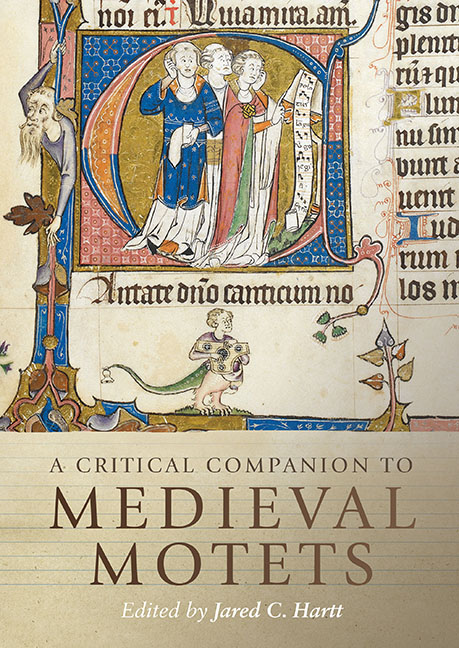Book contents
- Frontmatter
- Dedication
- Contents
- List of Figures
- List of Music Examples
- List of Tables
- List of Contributors
- Preface
- Acknowledgments
- Abbreviations
- Introduction: Approaching Medieval Motets
- 1 The Genre(s) of Medieval Motets
- 2 Origins and Interactions: Clausula, Motet, Conductus
- 3 Tracing the Tenor in Medieval Motets
- 4 Isorhythm
- 5 Notation
- 6 Thirteenth-Century Motet Functions: Views through the Lens of the Portare Motet Family
- 7 A Prism of its Time: Social Functions of the Motet in Fourteenth-Century France
- 8 Motets, Manuscript Culture, Mise-en-page
- 9 Clerics, Courtiers, and the Vernacular Two-Voice Motet: The Case of Fines amouretes / Fiat and the Roman de la poire
- 10 When Words Converge and Meanings Diverge: Counterexamples to Polytextuality in the Thirteenth-Century Mote
- 11 Motets in Chansonniers and the Other Culture of the French Thirteenth-Century Motet
- 12 Building a Motet around Quoted Material: Textual and Musical Structure in Motets Based on Monophonic Songs
- 13 The Duet Motet in England: Genre, Tonal Coherence, Reconstruction
- 14 Materia Matters: Reconstructing Colla/Bona
- 15 Machaut’s Motet 10 and its Interconnections
- 16 A Motet Conceived in Troubled Times: Machaut’s Motet 22
- 17 A Motet Ahead of its Time? The Curious Case of Portio nature/Ida capillorum
- Bibliography of Works Cited
- Select Glossary
- Index of Cited Motets
- General Index
- Studies in Medieval and Renaissance Music
3 - Tracing the Tenor in Medieval Motets
Published online by Cambridge University Press: 21 October 2020
- Frontmatter
- Dedication
- Contents
- List of Figures
- List of Music Examples
- List of Tables
- List of Contributors
- Preface
- Acknowledgments
- Abbreviations
- Introduction: Approaching Medieval Motets
- 1 The Genre(s) of Medieval Motets
- 2 Origins and Interactions: Clausula, Motet, Conductus
- 3 Tracing the Tenor in Medieval Motets
- 4 Isorhythm
- 5 Notation
- 6 Thirteenth-Century Motet Functions: Views through the Lens of the Portare Motet Family
- 7 A Prism of its Time: Social Functions of the Motet in Fourteenth-Century France
- 8 Motets, Manuscript Culture, Mise-en-page
- 9 Clerics, Courtiers, and the Vernacular Two-Voice Motet: The Case of Fines amouretes / Fiat and the Roman de la poire
- 10 When Words Converge and Meanings Diverge: Counterexamples to Polytextuality in the Thirteenth-Century Mote
- 11 Motets in Chansonniers and the Other Culture of the French Thirteenth-Century Motet
- 12 Building a Motet around Quoted Material: Textual and Musical Structure in Motets Based on Monophonic Songs
- 13 The Duet Motet in England: Genre, Tonal Coherence, Reconstruction
- 14 Materia Matters: Reconstructing Colla/Bona
- 15 Machaut’s Motet 10 and its Interconnections
- 16 A Motet Conceived in Troubled Times: Machaut’s Motet 22
- 17 A Motet Ahead of its Time? The Curious Case of Portio nature/Ida capillorum
- Bibliography of Works Cited
- Select Glossary
- Index of Cited Motets
- General Index
- Studies in Medieval and Renaissance Music
Summary
IN THE LATE FOURTEENTH CENTURY, Egidius de Murino wrote an elementary treatise on how to compose a motet. The first step, he told his readers, was to select a tenor appropriate for the theme of the motet:
Primo accipe tenorem alicuius antiphone vel responsorii vel alterius cantus de antiphonario et debent verba concordare cum materia de qua vis facere motetum.
First take the tenor from some antiphon or responsory or another chant from the antiphonal, and the words should concord with the matter of which you wish to make the motet.
After that, Egidius says, the tenor is arranged into phrases and given rhythm (a process he calls ‘ordering and coloring’), and the other parts are added – contratenor first, if there is one, then triplum and motetus. The upper-voice texts, according to this account, are added only at the end, by dividing the music and the words and combining them ‘as well as you can’.
It is important to remember that Egidius is writing for beginners, so he takes each stage in turn, while the experienced poet-composer would surely work on several levels simultaneously. The choice of a specific tenor may reflect not only a general sense of subject matter, but also the knowledge of certain key words, if not entire lines, of the upper-voice texts, or specific melodic features that the composer intends to work out in the polyphonic framework. In perhaps an extreme (but not unique) case, Anna Zayaruznaya makes a convincing argument that the composer of Colla / Bona had already written the texts and worked out the periodic structure of the motet before choosing the tenor and giving it a repetition pattern that is at odds with its upper voices. Moreover, a motet that borrows a tenor used in another motet creates a further dialogue that goes beyond general subject matter to include various aspects of structure, text, and music. The ways in which a composer might work out tenor choice and other aspects mentally resist the kind of clear linearity Egidius's description gives us.
- Type
- Chapter
- Information
- A Critical Companion to Medieval Motets , pp. 61 - 76Publisher: Boydell & BrewerPrint publication year: 2018



